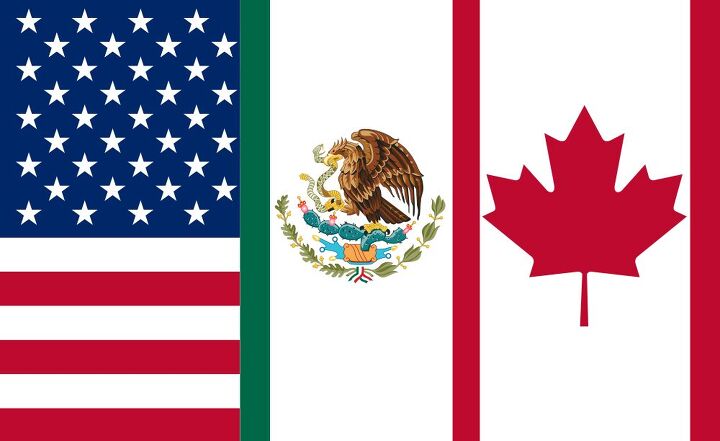NAFTA Renegotiations Begin, Automakers Worried Over Rules of Origin

The first round of the North American Free Trade Agreement renegotiations begins on Wednesday. U.S. President Donald Trump, Mexican President Enrique Peña Nieto, and Canadian Prime Minister Justin Trudeau have planned to meet in Washington, D.C. on August 16th and stay through the 20th to discuss trade policy. Afterward, NAFTA debates will be led by U.S. Trade Representative Robert Lighthizer, Canadian Foreign Minister Chrystia Freeland, and Mexican Economy Minister Ildefonso Guajardo.
While this all began as a Trump campaign promise to renegotiate a better deal for the United States (or abandon the trade agreement entirely), it has evolved over the last six months into an opportunity to modernize NAFTA policies. There’s no firm deadline for the three countries to reach an agreement, but Mexico is pushing for the process to wrap up before its presidential campaign begins in earnest in February.
The United States has said its primary goal for the talks is shrinking its $64 billion trade deficit with Mexico, as well as its $11 billion deficit with Canada. It also wants to strengthen NAFTA’s rules of origin, eliminate Chapter 19 trade dispute mechanisms, and stop currency manipulation among trading partners — even those that apply less to North American partners.
Automakers and suppliers have been clear they want ensure fluid movement of product between countries and are opposed to tightening the rules of origin, especially as they relate to vehicle parts.
“In terms of the rules of origin, the overall goal is to address concerns about doing more to incentivize and create more manufacturing and more manufacturing jobs in the United States,” an unnamed U.S. official told Reuters in an interview. “I think each country expects benefits for itself from those rules of origin, and I think that’s what you’re seeing reflected in our objective statement.”
U.S. Senator John McCain publicly cautioned the Trump administration not to force “new barriers that could harm our ability to trade with our closest neighbors.”
“I urge the administration to pursue an outcome that does not pick winners or losers, but further promotes the free flow of trade with Mexico and Canada that has and will continue to boost our economy,” said McCain.
Canada’s primary sticking point is the elimination of Chapter 19. Freeland has even gone so far as to suggest her country could walk away from the talks if the U.S. insisted on eliminating preexisting mechanisms to resolve trade disputes between the three NAFTA participants.
Speaking on Tuesday, prior to a meeting with Guajardo at the Canadian embassy in Washington, Freeland said she looked forward to a “productive, constructive conversation.” Meanwhile, Guajardo said he wanted to exercise caution.
“I have always said a negotiator cannot be an optimist. He has to be a realist with a positive approach,” he told reporters.
[Image: NAFTA Secretariat]

A staunch consumer advocate tracking industry trends and regulation. Before joining TTAC, Matt spent a decade working for marketing and research firms based in NYC. Clients included several of the world’s largest automakers, global tire brands, and aftermarket part suppliers. Dissatisfied with the corporate world and resentful of having to wear suits everyday, he pivoted to writing about cars. Since then, that man has become an ardent supporter of the right-to-repair movement, been interviewed on the auto industry by national radio broadcasts, driven more rental cars than anyone ever should, participated in amateur rallying events, and received the requisite minimum training as sanctioned by the SCCA. Handy with a wrench, Matt grew up surrounded by Detroit auto workers and managed to get a pizza delivery job before he was legally eligible. He later found himself driving box trucks through Manhattan, guaranteeing future sympathy for actual truckers. He continues to conduct research pertaining to the automotive sector as an independent contractor and has since moved back to his native Michigan, closer to where the cars are born. A contrarian, Matt claims to prefer understeer — stating that front and all-wheel drive vehicles cater best to his driving style.
More by Matt Posky
Latest Car Reviews
Read moreLatest Product Reviews
Read moreRecent Comments
- ToolGuy There was a time when in a place called America there were roads, and they were paved, and they were paved smoothly enough for a vehicle like this. Perhaps our next President will bring back that concept.
- ToolGuy I suppose I will listen before commenting. (TG, what a fair-minded dude!)
- ToolGuy "The technology is much more advanced to be better than a role model driver,”• Do any of you know what a "role model driver" is? No, I guess you wouldn't. 😉
- ToolGuy I might be Batman.
- Lou_BC Well, I'd be impressed if this was in a ZR2. LOL


































Comments
Join the conversation
According to the USTR, "The U.S. goods and services trade surplus with Canada was $12.5 billion in 2016". The US surplus in services was (as per USTR) $24.6 billion, which suggests a deficit in trade in goods alone of $12.1 billion. People manipulate these numbers to suit their agenda, but the aggregate of goods and services is the truest approach, especially as services have become a more and more important component of US foreign trade.
Are all Matt's articles void of substance and information? This is the second one I have come across today that was thinly veiled criticism and dislike without any merit.